-
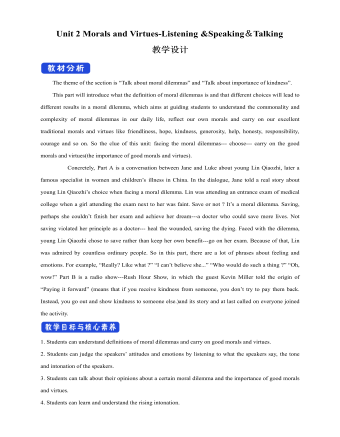
新人教版高中英语必修3Unit 2 Morals and Virtues-Listening &Speaking&Talking教学设计
Example:One day, a poor boy who was trying to pay his way through school by sending newspapers door to door found that he only had one dime(一角)left. He was so hungry that he decided to beg for a meal at the next house.However, he lost his nerve when a lovely young woman opened the door. Instead of a meal he asked for a drink of water. She thought he looked hungry so she brought him a large glass of milk. He drank it slowly, and then asked, “How much do I owe you?” “You don’t owe me anything,” she replied, “Mother has taught me never to accept pay for a kindness.” “Then I thank you from the bottom of my heart.” With these words, Howard Kelly left that house.Years later the woman became badly ill and was finally sent to the hospital in a big city. Dr. Howard Kelly, now famous, was called in. When he heard the name of the town she came from, a strange light filled his eyes. Dressed in his doctor’s clothes, Dr. Kelly went into her room and recognized her at once. From that day on, he gave special attention to her, and decided to do his best to save her life.At last the woman was saved. Dr. Kelly asked the business office to pass the final bill to him. He looked at it and then wrote something on the side. The bill was sent to the woman’s room. She was afraid to open it because she was sure that it would take the rest of her life to pay for it off. Finally she looked, and the note on the side of the bill caught her attention. She read these words: “Paid in full with a glass of milk, Dr. Howard Kelly.” Tear of joy flooded her eyes.

新人教版高中英语必修3Unit 2 Morals and Virtues-Reading and Thinking教学设计
The topic of this part is “Learn to make choices in life”.The Listening & Speaking & Talking part aims at the moral dilemmas, and this part is about making choices in life. The heroin is Lin Qiaozhi, a famous medical scientist, made a great contribution to our country’s medical care. Most importantly, her life experience can inspire our students whether in studying or the development of career. she had moral dilemmas and life choices, which are similar to the students who will step into society. Besides, Lin has quite good virtues like kindness, self-improvement, insistence, job-loving , generosity and responsibility, which is worth being learned.Concretely, this article is a biography about Lin Qiaozhi. The article tells her whole life according the timeline, among which the life choices is emphasized. For example, whether married or chased her dream, returned home or stayed abroad, family or public, her choices all reflected her faith, spirit, responsibility and devotion.1. Fast reading to get the detailed information about Lin Qiaozhi; careful reading to do the deductive information.2. Learn the reading skills--deductive judgement according the context.3. Study the structure features and language features. 4. Communicate about Lin’s life choices and reflect their own life choices.1. Learn the reading skills--deductive judgement according the context.2. Study the structure features and language features.3. Communicate about Lin’s life choices and reflect their own life choices.Step 1 Lead in---Small talkWhat are some important life choices?Importance choices: university study, jobs and marriage partners. Because they can determine our future.
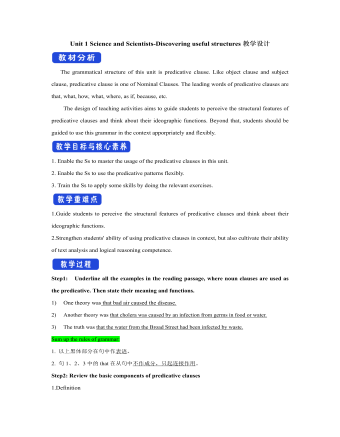
新人教版高中英语选修2Unit 1 Science and Scientists-Discovering useful structures教学设计
The grammatical structure of this unit is predicative clause. Like object clause and subject clause, predicative clause is one of Nominal Clauses. The leading words of predicative clauses are that, what, how, what, where, as if, because, etc.The design of teaching activities aims to guide students to perceive the structural features of predicative clauses and think about their ideographic functions. Beyond that, students should be guided to use this grammar in the context apporpriately and flexibly.1. Enable the Ss to master the usage of the predicative clauses in this unit.2. Enable the Ss to use the predicative patterns flexibly.3. Train the Ss to apply some skills by doing the relevant exercises.1.Guide students to perceive the structural features of predicative clauses and think about their ideographic functions.2.Strengthen students' ability of using predicative clauses in context, but also cultivate their ability of text analysis and logical reasoning competence.Step1: Underline all the examples in the reading passage, where noun clauses are used as the predicative. Then state their meaning and functions.1) One theory was that bad air caused the disease.2) Another theory was that cholera was caused by an infection from germs in food or water.3) The truth was that the water from the Broad Street had been infected by waste.Sum up the rules of grammar:1. 以上黑体部分在句中作表语。2. 句1、2、3中的that在从句中不作成分,只起连接作用。 Step2: Review the basic components of predicative clauses1.Definition
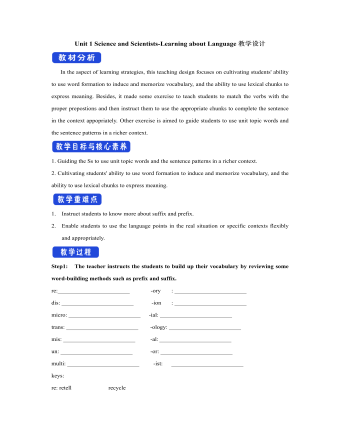
新人教版高中英语选修2Unit 1 Science and Scientists-Learning about Language教学设计
Step 7: complete the discourse according to the grammar rules.Cholera used to be one of the most 1.__________ (fear) diseases in the world. In the early 19th century, _2_________ an outbreak of cholera hit Europe, millions of people died. But neither its cause, 3__________ its cure was understood. A British doctor, John Snow, wanted to solve the problem and he knew that cholera would not be controlled _4_________ its cause was found. In general, there were two contradictory theories 5 __________ explained how cholera spread. The first suggested that bad air caused the disease. The second was that cholera was caused by an _6_________(infect) from germs in food or water. John Snow thought that the second theory was correct but he needed proof. So when another outbreak of cholera hit London in 1854, he began to investigate. Later, with all the evidence he _7_________ (gather), John Snow was able to announce that the pump water carried cholera germs. Therefore, he had the handle of the pump _8_________ (remove) so that it couldn't be used. Through his intervention,the disease was stopped in its tracks. What is more, John Snow found that some companies sold water from the River Thames that __9__________________ (pollute) by raw waste. The people who drank this water were much more likely _10_________ (get) cholera than those who drank pure or boiled water. Through John Snow's efforts, the _11_________ (threaten) of cholera around the world saw a substantial increase. Keys: 1.feared 2.when 3. nor 4.unless 5.that/which 6.infection 7.had gathered 8.removed 9.was polluted 10.to get 11. threat
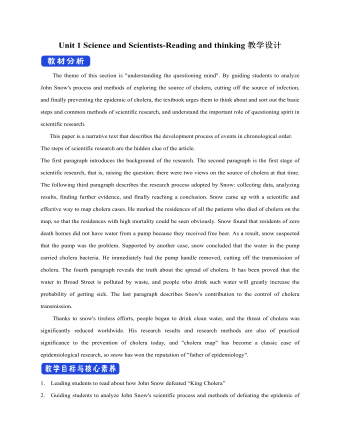
新人教版高中英语选修2Unit 1 Science and Scientists-Reading and thinking教学设计
Step 5: After learning the text, discuss with your peers about the following questions:1.John Snow believed Idea 2 was right. How did he finally prove it?2. Do you think John Snow would have solved this problem without the map?3. Cholera is a 19th century disease. What disease do you think is similar to cholera today?SARS and Covid-19 because they are both deadly and fatally infectious, have an unknown cause and need serious public health care to solve them urgently.keys:1. John Snow finally proved his idea because he found an outbreak that was clearly related to cholera, collected information and was able to tie cases outside the area to the polluted water.2. No. The map helped John Snow organize his ideas. He was able to identify those households that had had many deaths and check their water-drinking habits. He identified those houses that had had no deaths and surveyed their drinking habits. The evidence clearly pointed to the polluted water being the cause.3. SARS and Covid-19 because they are both deadly and fatally infectious, have an unknown cause and need serious public health care to solve them urgently.Step 6: Consolidate what you have learned by filling in the blanks:John Snow was a well-known _1___ in London in the _2__ century. He wanted to find the _3_____ of cholera in order to help people ___4_____ it. In 1854 when a cholera __5__ London, he began to gather information. He ___6__ on a map ___7___ all the dead people had lived and he found that many people who had ___8____ (drink) the dirty water from the __9____ died. So he decided that the polluted water ___10____ cholera. He suggested that the ___11__ of all water supplies should be _12______ and new methods of dealing with ____13___ water be found. Finally, “King Cholera” was __14_____.Keys: 1. doctor 2. 19th 3.cause 4.infected with 5.hit 6.marked 7.where 8.drunk 9.pump 10.carried 11.source 12.examined 13.polluted 14.defeatedHomework: Retell the text after class and preview its language points
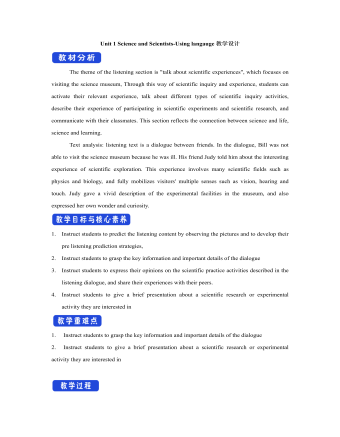
新人教版高中英语选修2Unit 1 Science and Scientists-Using langauge教学设计
This happens because the dish soap molecules have a strong negative charge, and the milk molecules have a strong positive charge. Like magnets, these molecules are attracted to each other, and so they appear to move around on the plate, taking the food coloring with them, making it look like the colors are quickly moving to escape from the soap.Listening text:? Judy: Oh, I'm so sorry that you were ill and couldn't come with us on our field trip. How are you feeling now? Better?? Bill: Much better, thanks. But how was it?? Judy: Wonderful! I especially liked an area of the museum called Light Games.it was really cool. They had a hall of mirrors where I could see myself reflected thousands of times!? Bill: A hall of mirrors can be a lot of fun. What else did they have?? Judy: Well, they had an experiment where we looked at a blue screen for a while, and then suddenly we could see tiny bright lights moving around on it. You'll never guess what those bright lights were!? Bill: Come on, tell me!? Judy: They were our own blood cells. For some reason, our eyes play tricks on us when we look at a blue screen, and we can see our own blood cells moving around like little lights! But there was another thing I liked better. I stood in front of a white light, and it cast different shadows of me in every color of the rainbow!? Bill: Oh, I wish I had been there. Tell me more!? Judy: Well, they had another area for sound. They had a giant piano keyboard that you could use your feet to play. But then, instead of playing the sounds of a piano, it played the voices of classical singers! Then they had a giant dish, and when you spoke into it, it reflected the sound back and made it louder. You could use it to speak in a whisper to someone 17 meters away.? Bill: It all sounds so cool. I wish I could have gone with you? Judy: I know, but we can go together this weekend. I'd love to go there again!? Bill: That sounds like a great idea!
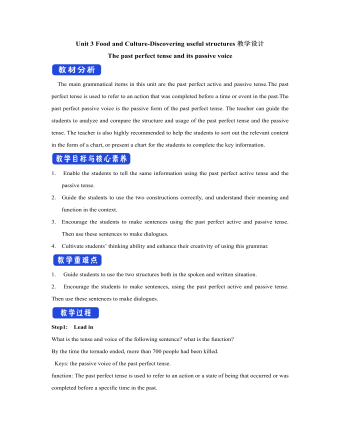
新人教版高中英语选修2Unit 3 Food and Culture-Discovering useful structures教学设计
The newspaper reported more than 100 people had been killed in the thunderstorm.报纸报道说有一百多人在暴风雨中丧生。(2)before、when、by the time、until、after、once等引导的时间状语从句的谓语是一般过去时,以及by、before后面接过去的时间时,主句动作发生在从句的动作或过去的时间之前且表示被动时,要用过去完成时的被动语态。By the time my brother was 10, he had been sent to Italy.我弟弟10岁前就已经被送到意大利了。Tons of rice had been produced by the end of last month. 到上月底已生产了好几吨大米。(3) It was the first/second/last ... time that ...句中that引导的定语从句中,主语与谓语构成被动关系时,要用过去完成时的被动语态。It was the first time that I had seen the night fact to face in one and a half years. 这是我一年半以来第一次亲眼目睹夜晚的景色。(4)在虚拟语气中,条件句表示与过去事实相反,且主语与谓语构成被动关系时,要用过去完成时的被动语态。If I had been instructed by him earlier, I would have finished the task.如果我早一点得到他的指示,我早就完成这项任务了。If I had hurried, I wouldn't have missed the train.如果我快点的话,我就不会误了火车。If you had been at the party, you would have met him. 如果你去了晚会,你就会见到他的。

新人教版高中英语选修2Unit 3 Food and Culture-Reading and thinking教学设计
The discourse explores the link between food and culture from a foreign’s perspective and it records some authentic Chinese food and illustrates the cultural meaning, gerography features and historic tradition that the food reflects. It is aimed to lead students to understand and think about the connection between food and culture. While teaching, the teacher should instruct students to find out the writing order and the writer’s experieces and feelings towards Chinese food and culture.1.Guide the students to read the text, sort out the information and dig out the topic.2.Understand the cultural connotation, regional characteristics and historical tradition of Chinese cuisine3.Understand and explore the relationship between food and people's personality4.Guide the students to use the cohesive words in the text5.Lead students to accurately grasp the real meaning of the information and improve the overall understanding ability by understanding the implied meaning behind the text.1. Enable the Ss to understand the structure and the writing style of the passage well.2. Lead the Ss to understand and think further about the connection between food and geography and local character traits.Step1: Prediction before reading. Before you read, look at the title, and the picture. What do you think this article is about?keys:It is about various culture and cuisine about a place or some countries.
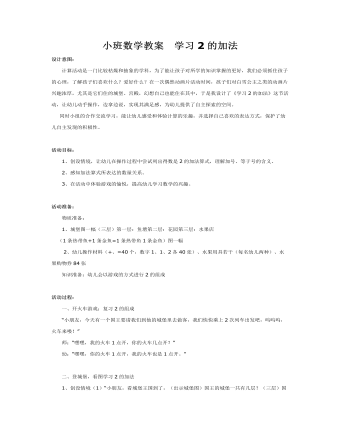
小班数学教案 学习2的加法
活动目标:1、创设情境,让幼儿在操作过程中尝试列出得数是2的加法算式,理解加号、等于号的含义。2、感知加法算式所表达的数量关系。3、在活动中体验游戏的愉悦,提高幼儿学习数学的兴趣。 活动准备: 物质准备:1、城堡图一幅(三层)第一层:鱼塘第二层:花园第三层:水果店 (1条热带鱼+1条金鱼=1条热带鱼1条金鱼)图一幅 2、幼儿操作材料(+、=40个,数字1、1、2各40张)、水果用具若干(每名幼儿两种)、水果购物券84张 知识准备:幼儿会以游戏的方式进行2的组成

人教版高中语文必修2《演讲》教案2篇
一个世纪前,一位了不起的美国人签署了奴隶解放宣言,而我们今天就站在他的塑像下面。对于千千万万身受不公正待遇之苦的黑奴来说,这份划时代的文件,是一座光芒万丈的希望灯塔,是结束他们被束缚之漫漫长夜的快乐黎明。我有一个梦,有朝一日在乔治亚州的丘陵地带,奴隶的后代与奴隶主的后代,将能够兄弟般地相处。我有一个梦,有朝一日甚至密西西比州,这个充满不平与压迫的州,将转化成一片自由与公正的绿洲。我有一个梦,我的四个孩子,有朝一日将可以生活在这样一个国度里:在此人们不是根据他们的肤色,而是根据他们的品行来衡量他们。我今天有一个梦!我有一个梦,有朝一日在阿拉巴马州,尽管目前有许多恶毒的种族主义者,尽管州长叫嚷着要与联邦政府对抗,有朝一日在阿拉巴马州,黑人孩子与白人孩子将会像兄弟姊妹那样亲密无间。
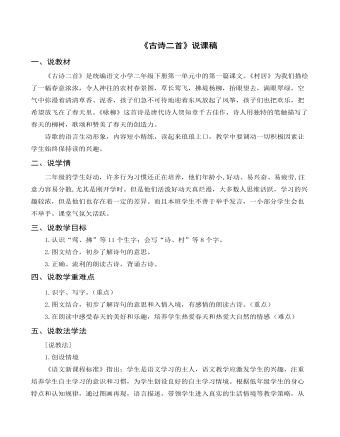
(说课稿) 《古诗二首》部编人教版二年级上册
二、说学情?? 二年级的学生好动,许多行为习惯还正在培养,他们年龄小,好动、易兴奋、易疲劳,注意力容易分散,尤其是刚开学时。但是他们活泼好动天真烂漫,大多数人思维活跃,学习的兴趣较浓,但是他们也存在着一定的差异。而且本班学生不善于举手发言,一小部分学生会也不举手。课堂气氛欠活跃。三、说教学目标1.认识“莺、拂”等11个生字;会写“诗、村”等8个字。2.图文结合,初步了解诗句的意思。3.正确、流利的朗读古诗,背诵古诗。四、说教学重难点1.识字、写字。(重点)2.图文结合,初步了解诗句的意思和入情入境,有感情的朗读古诗。(重点)3.在朗读中感受春天的美好和乐趣,培养学生热爱春天和热爱大自然的情感(难点)
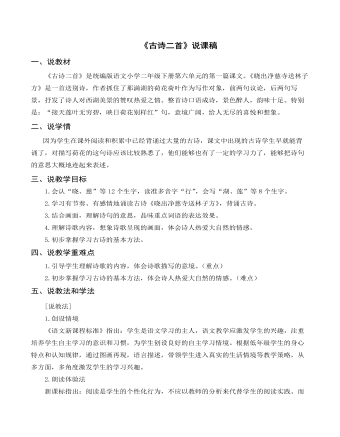
(说课稿)《 古诗二首》部编人教版二年级上册语文
一、说教材《古诗二首》是统编版语文小学二年级下册第六单元的第一篇课文。《晓出净慈寺送林子方》是一首送别诗,作者抓住了那满湖的荷花荷叶作为写作对象,前两句议论,后两句写景,抒发了诗人对西湖美景的赞叹热爱之情。整首诗口语成诗,景色醉人,韵味十足。特别是:“接天莲叶无穷碧,映日荷花别样红”句,意境广阔,给人无尽的喜悦和想象。二、说学情因为学生在课外阅读和积累中已经背诵过大量的古诗,课文中出现的古诗学生早就能背诵了,对描写荷花的这句诗应该比较熟悉了,他们能够也有了一定的学习力了,能够把诗句的意思大概地连起来表述。三、说教学目标1.会认“晓、慈”等12个生字,读准多音字“行”,会写“湖、莲”等8个生字。 2.学习有节奏、有感情地诵读古诗《晓出净慈寺送林子方》,背诵古诗。3.结合画面,理解诗句的意思,品味重点词语的表达效果。4.理解诗歌内容,想象诗歌呈现的画面,体会诗人热爱大自然的情感。5.初步掌握学习古诗的基本方法。
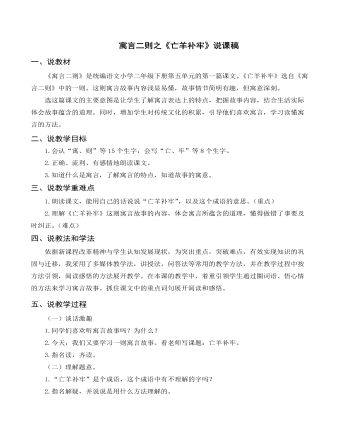
(说课稿)《寓言二则》部编人教版二年级上册语文
二、说教学目标1.会认“寓、则”等15个生字,会写“亡、牢”等8个生字。 2.正确、流利、有感情地朗读课文。3.知道什么是寓言,了解寓言的特点,知道故事的寓意。三、说教学重难点1.朗读课文,能用自己的话说说“亡羊补牢”,以及这个成语的意思。(重点)2.理解《亡羊补牢》这则寓言故事的内容,体会寓言所蕴含的道理,懂得做错了事要及时纠正。(难点)四、说教法和学法依据新课程改革精神与学生认知发展现状,为突出重点,突破难点,有效实现知识的巩固与迁移,我采用了多媒体教学法,讲授法,问答法等常用的教学方法,并在教学过程中按方法引领,阅读感悟的方法展开教学。在本课的教学中,着重引领学生通过圈词语、悟心情的方法来学习寓言故事。抓住课文中的重点词句展开阅读和感悟。
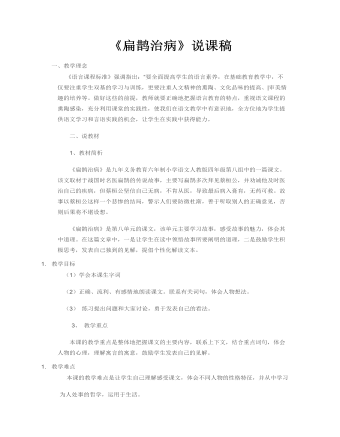
(新)部编人教版四年级上册《故事二则》说课稿(二)
一、教学理念《语言课程标准》强调指出:“要全面提高学生的语言素养,在基础教育教学中,不仅要注重学生双基的学习与训练,更要注重人文精神的熏陶、文化品味的提高、|审美情趣的培养等。做好这些的前提,教师就要正确地把握语言教育的特点,重视语文课程的熏陶感染,充分利用课堂的实践性,使我们在语文教学中有意识地,全方位地为学生提供语文学习和言语实践的机会,让学生在实践中获得能力。二、说教材1、教材简析《扁鹊治病》是九年义务教育六年制小学语文人教版四年级第八组中的一篇课文。该文取材于战国时名医扁鹊的传说故事,主要写扁鹊多次拜见蔡桓公,并劝诫他及时医治自己的疾病,但蔡桓公坚信自己无病,不肯从医,导致最后病入膏肓,无药可救。故事以蔡桓公这样一个悲惨的结局,警示人们要防微杜渐,善于听取别人的正确意见,否则后果将不堪设想。
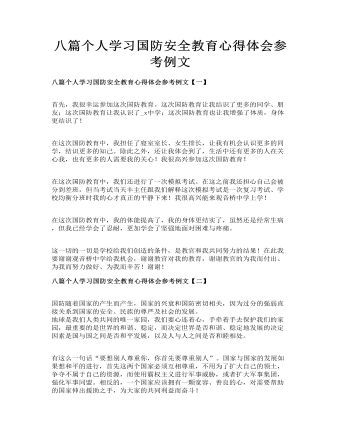
八篇个人学习国防安全教育心得体会参考例文
国防随着国家的产生而产生,国家的兴衰和国防密切相关,因为过分的强弱直接关系到国家的安全、民族的尊严及社会的发展。 地球是我们人类共同的唯一家园,我们要心连着心,手牵着手去保护我们的家园,最重要的是世界的和谐、稳定,而决定世界是否和谐、稳定地发展的决定因素是国与国之间是否和平发展,以及人与人之间是否和睦相处。 有这么一句话“要想别人尊重你,你首先要尊重别人”。国家与国家的发展如果想和平的进行,首先这两个国家必须互相尊重,不用为了扩大自己的领土,争夺不属于自己的资源,而使用霸权主义进行军事威胁,或者扩大军事集团,强化军事同盟。相反的,一个国家应该拥有一颗宽容、善良的心,对需要帮助的国家伸出援助之手,为大家的共同利益而奋斗!
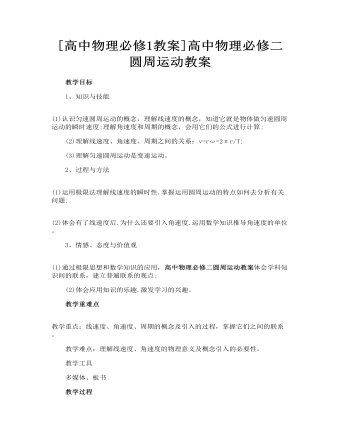
高中物理必修二圆周运动教案
1、知识与技能 (1)认识匀速圆周运动的概念,理解线速度的概念,知道它就是物体做匀速圆周运动的瞬时速度;理解角速度和周期的概念,会用它们的公式进行计算; (2)理解线速度、角速度、周期之间的关系:v=rω=2πr/T; (3)理解匀速圆周运动是变速运动。 2、过程与方法 (1)运用极限法理解线速度的瞬时性.掌握运用圆周运动的特点如何去分析有关问题; (2)体会有了线速度后.为什么还要引入角速度.运用数学知识推导角速度的单位。
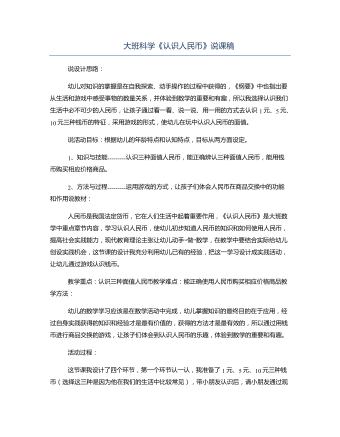
大班科学《认识人民币》说课稿
1、知识与技能---------认识三种面值人民币,能正确辨认三种面值人民币,能用钱币购买相应价格商品。2、方法与过程---------运用游戏的方式,让孩子们体会人民币在商品交换中的功能和作用说教材:人民币是我国法定货币,它在人们生活中起着重要作用,《认识人民币》是大班数学中重点章节内容,学习认识人民币,使幼儿初步知道人民币的知识和如何使用人民币,提高社会实践能力,现代教育理论主张让幼儿动手“做”数学,在教学中要结合实际给幼儿创设实践机会,这节课的设计我充分利用幼儿已有的经验,把这一学习设计成实践活动,让幼儿通过游戏认识钱币。教学重点:认识三种面值人民币教学难点:能正确使用人民币购买相应价格商品教学方法:

北师大版初中八年级数学上册平方根说课稿2篇
让学生先独立解决⑴题,再小组交流⑵题的答案,找到解题的方法.2、例2,例3是对平方根概念的巩固与拓展,在例2中由于学生还不熟于平方根的表示方法,所以应在平方根的概念和±号上加以明确,而例3则要把握平方根概念的本质,根据该数的正负或0来确定其平方根,这部分内容可用板演或展台展示结果的方式进行,让学生独立完成,应给予恰当的评价.3、最后,我又设计了一道辨析题:在做一道求4的平方根的题目时,小明说:“4的平方根是2”,小红说:“4的平方根是-2”,小强说:“2是4的平方根”小芳说:“-2是4的平方根”,请问他们的说法正确吗?通过这道题目,使学生在熟悉平方根概念的基础上更加深理解,同时对以往五种运算中从未出现过的一题两解的现象作出了解释,使学生明白了一种整体与局部的关系,再一次突出了重点.

北师大版初中八年级数学上册三角形内角和定理说课稿2篇
三、说教法和学法:1、说教法:本节课采用几何画板与电子白板相结合的教学手段,使操作过程形象、直观呈现,以便学生更好的理解。在教学过程中,引导学生去探索,使学生感受到添加辅助线的数学思想,更好地掌握三角形内角和定理的证明及简单的应用,2、说学法:根据本节课特点和学生的实际,在教学过程中给学生足够的时间认真、仔细地动手书写证明过程,使学生的学习落到实处。同时,培养学生科学的学习方法和自信心。四、说教学过程设计教学过程的设计有:1、问题引入新课:七年级已经学习三角形内角和定理内容。这样从已经学过的知识引入,符合学生的认知规律。在拼图活动中发展思维的灵活性、创造性,为下一环节“说理”证明作好准备,使学生体会到数学来源于实践,同时对新知识的学习有了期待。
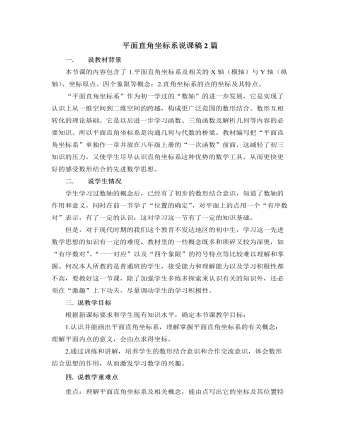
北师大版初中八年级数学上册平面直角坐标系说课稿2篇
【设计意图】:这一环节的设计主要是为了培养学生自主学习的能力,让学生在自学中初步认识概念。通过材料的阅读,活动的实践,让学生在自画、自纠中,加深对概念的理解,培养学生良好的画图习惯。(三)例题讲解学生活动4:(由于例题都比较简单,所以让学生自己先做,教师巡视指导)例1、写出图中A、B、C、D、E各点的坐标。例2、在直角坐标系中,描出下列各点:A(4,3), B(-2,3),C(-4,-1),D(2,-2)。【设计意图】:例1的目的是给出点的位置,写出点的坐标。例2的目的是给出点的坐标,描出点。学完概念之后,马上对概念进行应用,达到巩固的目的。当时上课时这2道例题的解答都比较圆满,绝大部分学生都能顺利做出。

